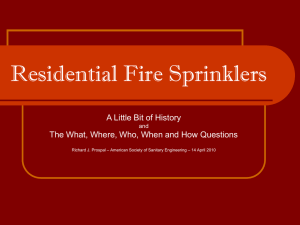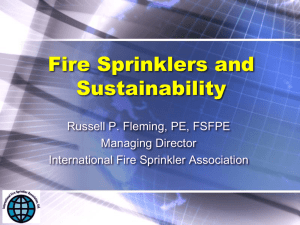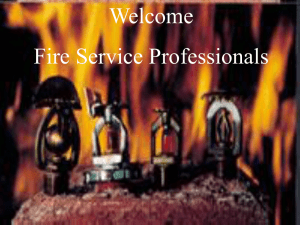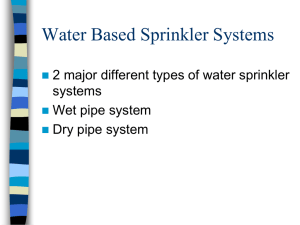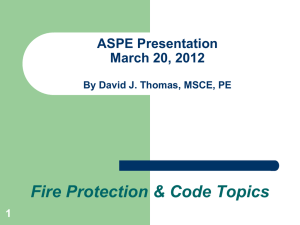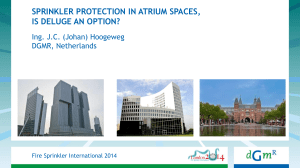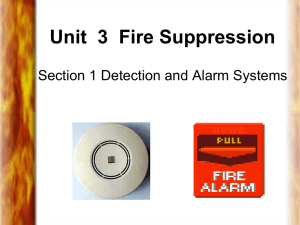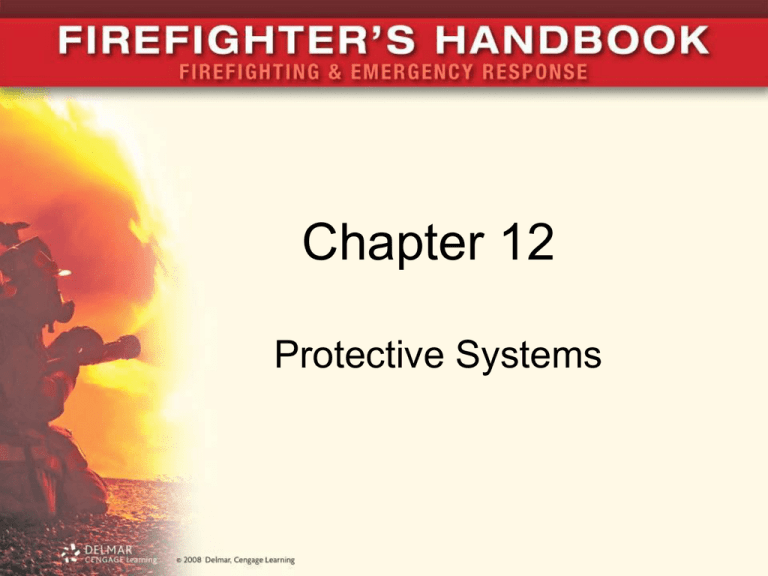
Chapter 12
Protective Systems
Introduction
• Protective systems help guard lives
and property
• Detection systems detect presence
of fire and alert occupants and/or fire
department
• Suppression systems help
firefighters in controlling fires
• Detection systems are varied
• Three systems can be combined to
form protective ensemble
12.2
Detection Systems
• Designed to notify people
• Simple systems warn person to
recognize danger
• Complex systems use series of
devices to automatically detect event
and initiate alarm
12.3
People or Manual Systems
• People can alert other people and call
fire department after discovering a fire
• Requires a person to discover a fire
and pull the alarm
• Two typical problems:
– Person must be present, awake, and alert
– Systems are local only
12.4
Heat Detectors
• Detect heat of fire at fixed
temperature or as rising
temperature builds at rapid rate
• Can be used as part of a
suppression system
• Slow to detect fires
• Inexpensive with low rate of false
alarms
• Spot type or line type
12.5
Figure 12-1 Rate-of-rise heat detector.
12.6
Smoke Detectors
• Smoke and toxic gases are leading
killers of people in residential
structure emergencies
• Most prevalent automatic detection
system
• Can be hard wired, battery operated,
or a combination
• Ionization detectors are the most
common type
12.7
Gas Detectors
• Designed to find presence of certain
gases prior to reaching a concentration
• Carbon monoxide detectors for home
are popular
• CO detectors function using several
different methods
• Most provide an early warning alarm
12.8
Combination Smoke/Carbon
Monoxide Detectors
• Simplify things for the builder
• Can make discerning situation more
difficult for firefighters
– Detector manufacturers have added
different alarms and colored lights for
each situation
– Excited homeowner may not correctly
distinguish between the two
– Some manufacturers have added voice
prompts
12.9
Flame Detectors
• Detect flames or lightwaves
– Ultraviolet
– Infrared
– Combined ultraviolet-infrared
• Very sensitive and quick to alarm
• Used to protect petroleum and chemical
facilities
12.10
Sprinkler Systems
• Designed to automatically distribute
water through sprinklers
• Usually in the ceiling
• Most sprinkler heads detect heat
• Highly effective
12.11
Sprinklers and Life Safety
• Originally designed in late 1800s
• Intent was to protect business and
industrial property
• Almost 100 percent effective
• Failure due to two reasons:
– Improper maintenance
– Inadequate water supply
12.12
Sprinkler Head Design
and Operation
• Sprinkler heads are the key component
• Deluge-type have separate detection
devices
• Come in many designs:
– Old-style sprinklers
– New style or standard sprinklers
• May require:
– Corrosion-resistant heads
– Dry head with extension piping
– Rack storage head, decorative head
12.13
Types of Sprinkler Systems
• Some sprinkler systems protect:
– Homes or apartment buildings
– Buildings with highly sensitive electronic
equipment
– Homes and businesses in areas subject
to harsh winter conditions
12.14
Specialty Sprinkler Systems
• Include some combination-type
sprinkler system and systems that
cannot meet standards
• May have inadequate water source or
supply
• Fire departments must be familiar with
limitations and intended protection
strategy
12.15
Wet Pipe Systems
• Automatic sprinklers attached to pipes
with water under constant pressure
• Quick response
• Simplest sprinkler system in design
and operation
Figure 12-11 Wet pipe sprinkler system.
12.16
Dry Pipe Systems
• Air under pressure replaces water
• Uses a dry pipe valve
• More complex in design than a wet pipe
system
• Harder to return to service after activation
Figure 12-14 Dry pipe system schematic.
12.17
Deluge Systems
• Designed to protect areas that may
have fast-spreading fire
• Must interface with a detection
system
• Causes tremendous quantities of
water to flow
12.18
Figure 12-16 Deluge system schematic: 1, OS&Y valve; 2,
deluge valve with basic trim; 3, solenoid valve and electric
actuation trim; 4, pressure alarm switch; 5, water motor alarm;
6, spray nozzles or open sprinklers; 7, deluge releasing panel;
8, electric manual control stations; 9, fire alarm bell; 10, trouble
horn; 11, heat detectors. (© Copyright Simplex Grinnell. All
rights reserved.)
12.19
Pre-action Systems
• Similar to dry pipe and deluge system
• Closed piping and heads with air
under no or little pressure
• Water flows from separate fire
detection system
• Found in computer rooms, museums,
or buildings storing historical items
12.20
Figure 12-17 Pre-action system schematic: 1, OS&Y valve; 2,
deluge valve with basic trim; 3, check valve; 4, solenoid valve
and electric actuation trim; 5, water pressure alarm switch; 6,
1.5-psi low air pressure alarm switch; 7, 1.5-psi supervisory air
pressure control; 8, water motor alarm; 9, automatic sprinklers;
10, deluge releasing panel; 11, electric manual control stations;
12, fire alarm bell; 13, trouble horn; 14, heat detectors. (©
Copyright Simplex Grinnell. All rights reserved.)
12.21
Residential Systems
• Smaller and more affordable version
of wet or dry pipe systems
• Water supply combined with
domestic water supply
• Designed for one or a few heads
• Use lighter and smaller piping
• First suppression system to use
plastic piping
• Some use antifreeze
12.22
Sprinkler Systems
Connections and Piping
• Comprise most of the components of
sprinkler system
• Water comes from public or private
water
• Secondary source supplied via fire
department connection
• Firefighter should be able to connect
supply line to fire department
connection
12.23
Control Devices for
Sprinkler Systems
• Three main control devices:
– Outside stem and yoke valve (OS&Y)
– Post indicator valve (PIV)
– Wall indicator valve (WIV)
12.24
Returning Sprinkler
Systems to Service
• Most departments no longer provide
testing or service
• Once fire is extinguished, firefighters
should leave at least one charged
hoseline in place
• Simplest and quickest way to stop water
flow from sprinkler head is to insert a stop
• Once system is shut down, heads may be
replaced
• Fire watch established until system is
restored
12.25
Figure 12-25 Sprinkler tongs and wood wedges stopping sprinkler
flow.
12.26
Standpipe Classifications
• Designed to allow firefighters to fight
fires in larger buildings by pre-piping
water
• Classified according to intended user
– Class I
– Class II
– Class III
• Differentiated based on water supply
12.27
Figure 12-27 Class II standpipe system.
12.28
Standpipe System
Connections and Piping
• Range from very simple to highly
complex
–
–
–
–
–
Piping
Outlets with hose and other attachments
Valves
Fire department connection
Any monitoring devices
• Standpipe valves similar to vales
used on sprinkler systems
12.29
Alarms for Standpipes
and Sprinklers
• Found in most sprinkler and standpipe
systems
• Most protective systems require
monitoring to prevent tampering
• Monitoring alarm company notifies fire
department about fires
– Company responds on its own to
tampered alarms
12.30
Other Protective Systems
• Many other types are used today
• Some are rather simple:
– Grill
– Fryer
– Ductwork
• Others are extremely complex and
designed to prevent or suppress an
explosion
• All firefighters responding need to be
familiar with operation of complex
systems
12.31
Local Application
and Hood Systems
• One of the most common types of protective
systems is a local application system
• Protects only a certain portion of building
• Also used in:
– Laboratory hoods
– Paint booths
– Small hazardous locations
• Use heat-sensitive device or manual switch
for activation
12.32
Total Flooding Systems
• Used to protect an entire area, room,
or building
• Discharges an extinguishing agent
• Effective as long as proper amount
discharges
12.33
Fire Department Operations
with Protective Systems
• Standpipe, sprinkler, and other
protective systems are part of fire
department strategy plan
• Strategy recognizes community’s
hazards
• Protective systems required when
properties or processes create
hazards beyond certain limits
• Protective systems can be separate
components
12.34
Standpipe Operations
• Start with establishing water supply to fire
department connection
• Pump operator should immediately charge
standpipe system
• Personnel should check annunciator panel
• Fire crews should stop at least two floors
below reported fire level
• Personnel should have full protective
equipment, standpipe pack, and forcible
entry equipment
12.35
Sprinkler System Operations
• Begin with investigation of building
• First arriving officer check
annunciator panel
• Pump operator should charge
sprinkler system
• Personnel should advance hoseline
into fire area
• If no fire is found, officer may direct
firefighters to stop sprinkler flow
12.36
Detector Activation
Operations
• Histories of false alarms have caused
firefighters to take a less than ready
approach
• Firefighters must treat all fire alarm
activities as an actual fire
• Firefighters should dismount wearing full
PPE, SCBA, and carry necessary tools and
radio
• At commercial structures, first arriving crew
checks annunciator panel
• Do not turn off alarms prematurely
12.37
Operations for Other
Protective Systems
• Local SOPs should address operations for:
–
–
–
–
Total flooding
Foam
Dry chemical
Other unique systems
• Clean up of foam is not responsibility of fire
department, but occupants must be warned
• Activation of suppression systems may
cause secondary damage
12.38
Lessons Learned
• Protective systems designed to
automatically detect or suppress a fire
– Apply water or other extinguishing agents
• Sprinkler systems used for detection and
suppression
– Apply water or foam
• Standpipe systems facilitate manual fire
suppression
• Fire department operations at buildings with
protective systems outlined in SOPs
12.39


